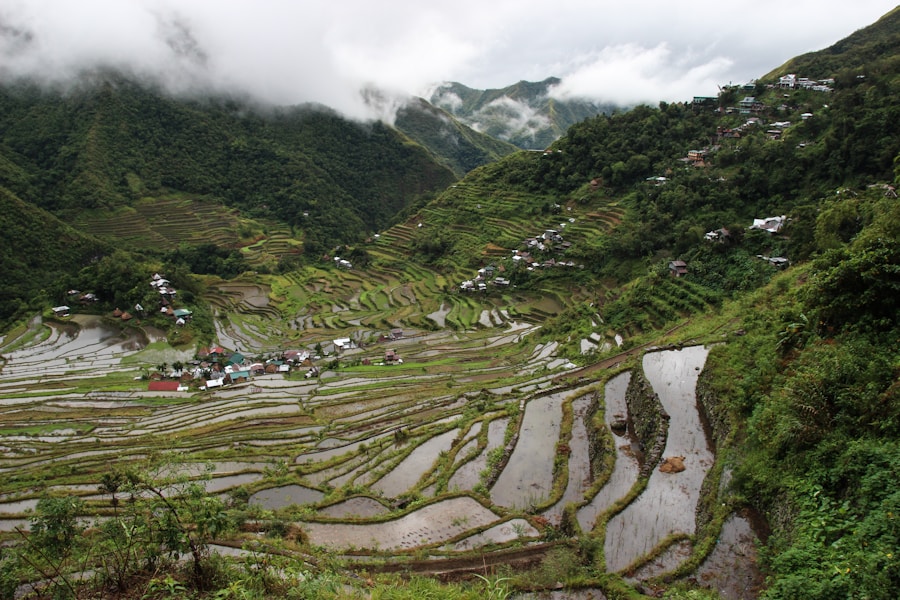Download links
How to install Banaue Rice Terraces: A Marvel of Ancient Engineering APK?
1. Tap the downloaded Banaue Rice Terraces: A Marvel of Ancient Engineering APK file.
2. Touch install.
3. Follow the steps on the screen.
Description
Nestled in the mountainous region of the Philippines, the Banaue Rice Terraces are often referred to as the “Eighth Wonder of the World.” This breathtaking landscape, carved into the mountainsides over 2,000 years ago, showcases the ingenuity and resilience of the indigenous Ifugao people. The terraces stretch across approximately 2,000 square kilometers and rise to elevations of about 1,500 meters above sea level. They are not merely agricultural fields; they represent a harmonious relationship between humans and nature, where traditional farming practices have been meticulously maintained over generations.
The terraces are a testament to the Ifugao’s sophisticated agricultural techniques, which have allowed them to cultivate rice in an environment that would otherwise be inhospitable for farming. The intricate system of irrigation channels, stone walls, and terraces demonstrates a deep understanding of the local ecosystem and climate. As a UNESCO World Heritage Site since 1995, the Banaue Rice Terraces are recognized not only for their stunning beauty but also for their cultural significance and historical importance.
They attract thousands of visitors each year, eager to witness this remarkable feat of engineering and to learn about the rich traditions of the Ifugao people.
Key Takeaways
- The Banaue Rice Terraces are an ancient agricultural wonder located in the Philippines, often referred to as the “Eighth Wonder of the World.”
- The terraces have a rich history and cultural significance to the indigenous people of the Ifugao region, who have been cultivating the land for over 2,000 years.
- The engineering feats of the Banaue Rice Terraces include the use of stone walls and irrigation systems that have sustained the terraces for centuries.
- While the terraces have had a positive impact on the environment by preserving biodiversity, they also face challenges such as soil erosion and climate change.
- Preservation efforts for the Banaue Rice Terraces include UNESCO World Heritage status and sustainable tourism initiatives, offering visitors a unique cultural experience.
The History and Cultural Significance of the Banaue Rice Terraces
The origins of the Banaue Rice Terraces can be traced back over two millennia, with estimates suggesting that they were constructed around 2000 years ago. The Ifugao people, who inhabit this region, developed these terraces as a response to their need for sustainable agriculture in a challenging mountainous terrain. The construction of the terraces was not merely a practical endeavor; it was deeply intertwined with their cultural identity and spiritual beliefs.
The Ifugao view rice as more than just a staple food; it is a symbol of life, prosperity, and social status. Rituals and ceremonies surrounding rice cultivation are integral to their culture, reflecting their reverence for nature and ancestral spirits. The terraces also serve as a living testament to the Ifugao’s social structure and communal values.
The construction and maintenance of these terraces require collective effort, fostering a sense of community among the Ifugao people. Each family typically owns a section of the terraces, and their success is linked to the well-being of the entire community. This interconnectedness is evident in traditional practices such as the “pattong,” a communal work party where families come together to help one another with farming tasks.
Such customs not only ensure the sustainability of rice production but also reinforce social bonds and cultural heritage.
The Engineering Feats of the Banaue Rice Terraces

The engineering prowess displayed in the Banaue Rice Terraces is nothing short of extraordinary. The terraces were constructed using simple tools and techniques that have been passed down through generations. The Ifugao people utilized locally sourced materials such as stone, mud, and bamboo to create a complex system of terraces that effectively manage water flow and soil erosion.
Each terrace is meticulously designed to capture rainwater and channel it through a network of irrigation systems that distribute water evenly across the fields. One of the most remarkable aspects of the terraces is their adaptability to the natural landscape. The Ifugao ingeniously shaped the contours of the mountains to create flat surfaces for planting rice while ensuring that water could flow freely from one terrace to another.
This careful planning minimizes water loss and maximizes agricultural yield. Additionally, the use of stone walls not only supports the terraces but also prevents soil erosion, which is crucial in maintaining soil fertility over time.
The Environmental Impact of the Banaue Rice Terraces
| Aspect | Metric |
|---|---|
| Deforestation | Over 60% of the original forest cover has been lost due to terrace construction and agricultural expansion. |
| Biodiversity | The terraces support a rich diversity of plant and animal species, including several endemic species. |
| Soil Erosion | Intensive farming practices have led to significant soil erosion, impacting the long-term sustainability of the terraces. |
| Water Management | The terraces are an impressive example of traditional water management systems, which have been recognized for their efficiency and sustainability. |
| Climate Change | The terraces play a role in mitigating climate change by sequestering carbon and providing a sustainable agricultural system. |
The Banaue Rice Terraces have had a significant impact on the local environment, both positive and negative.
The rice paddies provide habitat for various species of birds, insects, and aquatic life, contributing to a rich tapestry of flora and fauna in the region.
The careful management of water resources through the terraces has also helped maintain soil health and prevent erosion, allowing for sustainable agricultural practices that have persisted for centuries. However, the environmental challenges facing the Banaue Rice Terraces cannot be overlooked. Climate change poses a significant threat to this delicate ecosystem, with rising temperatures and unpredictable weather patterns affecting rice production.
Additionally, deforestation and land conversion for other agricultural purposes have led to increased soil erosion and loss of biodiversity in surrounding areas. The traditional farming practices that have sustained the terraces for generations are increasingly at risk as younger generations migrate to urban areas in search of better opportunities, leading to neglect and abandonment of these vital agricultural systems.
Preservation Efforts and Challenges for the Banaue Rice Terraces
Preserving the Banaue Rice Terraces is crucial not only for maintaining agricultural productivity but also for safeguarding cultural heritage. Various organizations, including local government units and non-governmental organizations, have initiated preservation efforts aimed at revitalizing interest in traditional farming practices among younger generations. Educational programs that emphasize the importance of sustainable agriculture and cultural heritage are being implemented to encourage local youth to engage with their ancestral traditions.
Despite these efforts, numerous challenges persist in preserving the terraces. Economic pressures often lead families to abandon rice farming in favor of more lucrative ventures such as tourism or mining. Additionally, natural disasters such as landslides and typhoons can cause significant damage to the terraces, further complicating preservation efforts.
The delicate balance between promoting tourism and protecting cultural heritage is another challenge faced by local communities. While tourism can provide much-needed income, it can also lead to environmental degradation if not managed sustainably.
Visiting the Banaue Rice Terraces: A Unique Cultural Experience

Exploring the Terraces
Tourists can explore various viewpoints that provide stunning panoramas of the terraces, each offering a unique perspective on this agricultural marvel. Guided tours led by local Ifugao guides enrich the experience by providing insights into traditional farming practices, cultural rituals, and the history behind these remarkable structures.
Immersing in Local Culture
In addition to sightseeing, visitors can participate in cultural activities that allow them to engage with the local community. Traditional Ifugao dances, cooking classes featuring local cuisine, and hands-on experiences in rice planting or harvesting provide an authentic glimpse into daily life in this region. Such interactions foster mutual respect and understanding between visitors and locals while supporting sustainable tourism initiatives that benefit the community economically.
A Symbol of Cultural Pride
The Banaue Rice Terraces stand as a symbol of resilience, ingenuity, and cultural pride for the Ifugao people. As visitors traverse this breathtaking landscape, they not only witness an extraordinary feat of engineering but also become part of a living narrative that celebrates human connection with nature and tradition.
FAQs
What are the Banaue Rice Terraces?
The Banaue Rice Terraces are ancient terraces carved into the mountains of Ifugao in the Philippines. They are often referred to as the “Eighth Wonder of the World” and are a UNESCO World Heritage Site.
How were the Banaue Rice Terraces created?
The terraces were hand-carved over 2,000 years ago by the ancestors of the indigenous Ifugao people using minimal equipment. They were created to make the mountainous terrain suitable for rice cultivation.
What is the significance of the Banaue Rice Terraces?
The terraces are not only a stunning example of ancient engineering and agricultural practices, but they also hold cultural and spiritual significance for the Ifugao people. They are a symbol of their connection to the land and their ancestors.
How big are the Banaue Rice Terraces?
The terraces cover approximately 10,360 square kilometers of mountainside and are estimated to stretch about 20,000 kilometers if laid end to end.
Can visitors explore the Banaue Rice Terraces?
Yes, visitors are welcome to explore the terraces and the surrounding villages. There are hiking trails and guided tours available for those who want to experience the beauty and history of the area.





